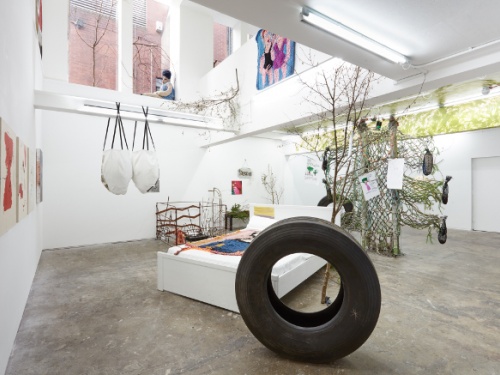Speech Matters: Violence and the Feminist Voice
Ahead of our Friday Salon Speeches for Becoming, Rose Gibbs explores the significance of speech-making and the ways in which the feminist voice—as both politically unifying and uniquely personal—can challenge oppressive structures.
From the crucial speeches given by Suffragettes during the mid-19th and early 20th centuries, to the closed consciousness-raising groups of the 1960s and 70s women’s movement, the voice has played a key role in the fight for gender equality.
Hannah Arendt writes that speech is possible only as part of a group and is a specifically human way of answering to violence [PDF]. It is no surprise then that the most incisive speeches are those of 19th century African American women for whom the task of addressing violence was most urgent.
"The voice can be used as a powerful tool for feminist action."
In America it was not until the mid-19th century that the prohibition against women speaking in public began to be lifted, and it was at a Women’s Rights Convention in Ohio that Sojourner Truth extemporaneously delivered her momentous Ain’t I a Woman speech. In it she highlights not only the violence she faces as a woman, but the violence she faces as an African American – a violence that persists to this day with the brutal murder of innocent black people at the hands of the police.
Britain too sees people of colour subject to a prejudiced law enforcement system, causing a breakdown of trust in police protection across BAME communities. It is inevitable then that when it comes to tackling domestic abuse, BAME [Black, Asian and minority ethnic] women are underreporting. In a climate of racial antagonism, BAME women are pressured to suffer in silence, rather than expose those who are most often the perpetrators of domestic violence—their partners and family members—to the ‘outside’.
This situation demonstrates the division of the private and public spheres enshrined in the philosophical tradition of western thought. Where Platonic thought condemns violence as base and inhuman in the polis, it is condoned as necessary to the maintenance of life within the private domain of the home:
“In Greek self-understanding, to force people by violence, to command rather than persuade, were pre-political ways to deal with people characteristic of life outside the polls, of home and family life, where the household head ruled with uncontested, despotic powers." Hannah Arendt
Within this paradigm, women are chattel not worthy of rights: this can be seen to play out on an international level where the rape of women is still used as an instrument of war and genocide, and on a state level within the family - in the UK marital rape was criminalised until 1991. International human rights lawyer Catherine MacKinnon [PDF] describes it thus:
"State boundaries define the line where men divide power among themselves….Men respect other men’s control over their own domains in the hope and expectation of reciprocity: the male bond."
It is this tradition in which men are the operators in the public sphere of politics and women are deprived of a voice that Sylvia Pankhurst and The East London Federation of Suffragettes sought to challenge with their speech-making workshops for working-class women. Here socialism was combined with the fight for gender equality in workshops that sought to provide women with the tools with which to take their concerns out into the public domain.
This finding of a public voice can also be seen in the consciousness raising groups of the 1960s and 70s. With women’s issues relegated to the margins, the need to make them visible—a process that began with consciousness-raising sessions—underpinned the slogan the personal is political [PDF]. Though closed to the public these sessions invited women to talk about themselves and their lives as a first step towards recognising and calling out sexist patterns of behaviour.
"Feminism seeks horizontal modes of communication that recognise the violence of the structural inequality that shapes the status quo."
These sessions acknowledged and sought to account for power dynamics present in any group of people. In recognition of privilege and entitlement, members of these feminist groups took turns to speak in efforts not to treat others as they themselves had been treated as women.
Unlike mainstream political discourse, which operates on the basis of voices dominating over each other and sees personalities vie for power, here equal treatment of others is understood as integral to a politically ethical message. Preaching equality must begin with treating people equally: this means prioritising listening and taking the time to lift up the quiet voices that are all too often sidelined.
It is these guiding principals that can be seen at play within the behaviour of any feminist or feminist group worthy of its name. In a similar way to anarchism, feminism seeks horizontal modes of communication that recognise the violence of the structural inequality that shapes the status quo.
Here consciousness-raising makes space for two actions to take place – it gathers people together while also allowing for difference within the grouping. The voice is well suited to carry these seemingly contradictory aims: it is both unique and personal. It implicates a “fleshy cavity that alludes to the deep body” [Adriana Cavarero] while it can at the same time be used with others to assert group unity (through protest, through song).
"The voice brings women’s concerns into the public sphere, while all the time reminding us that each person is individual."
The voice can therefore be used as a powerful tool for feminist action: it engenders relationality and can bring women into the public and political realm while at the same time retaining a primary uniqueness of a specific personal “throat of flesh”. The voice carries speech and language but is not limited to the “abstract and bodiless universality” that dominates western philosophy: it is also a “sonorous emission”, the “musical side of language…that is bound to the rhythms of the body in a way that destabilizes the rational register on which the system of speech is built." [Cavarero]
In an era that relentlessly uses images of women, the voice is well suited to meet the challenges that feminism faces. It eludes the commodifying gaze of the corporal surface, and brings our attention to the internal body. It relates people to one another through speech and brings women’s concerns into the public sphere, while all the time reminding us that each person is individual, that one person can never speak for everyone. ■
Speeches for Becoming takes place on 12 August.
This article is posted in: Articles, Blog, Events
Tagged with: Voice, Feminism, Rose Gibbs, Catherine Long, learning, Sufragettes, Sojourner Truth, Women's Rgihts, Speech-making, Plato, Gender Equality, Consciousness-raising, Sylvia Pankhurst, The East London Federation of Suffragettes, politics, activism, Feminist Activism








